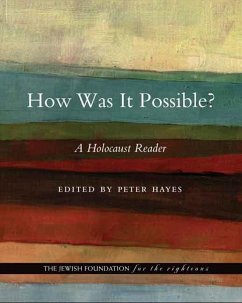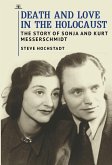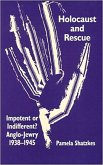How Was It Possible?
A Holocaust Reader
Herausgeber: Hayes, Peter
How Was It Possible?
A Holocaust Reader
Herausgeber: Hayes, Peter
- Broschiertes Buch
- Merkliste
- Auf die Merkliste
- Bewerten Bewerten
- Teilen
- Produkt teilen
- Produkterinnerung
- Produkterinnerung
As the Holocaust passes out of living memory, future generations will no longer come face-to-face with Holocaust survivors. But the lessons of that terrible period in history are too important to let slip past. How Was It Possible?, edited and introduced by Peter Hayes, provides teachers and students with a comprehensive resource about the Nazi persecution of Jews. Deliberately resisting the reflexive urge to dismiss the topic as too horrible to be understood intellectually or emotionally, the anthology sets out to provide answers to questions that may otherwise defy comprehension. This…mehr
Andere Kunden interessierten sich auch für
![Good Neighbors, Bad Times Revisited Good Neighbors, Bad Times Revisited]() Mimi SchwartzGood Neighbors, Bad Times Revisited23,99 €
Mimi SchwartzGood Neighbors, Bad Times Revisited23,99 €![Like Leaves in the Wind Like Leaves in the Wind]() Rita Blattberg BlumsteinLike Leaves in the Wind29,99 €
Rita Blattberg BlumsteinLike Leaves in the Wind29,99 €![Death and Love in the Holocaust Death and Love in the Holocaust]() Steve HochstadtDeath and Love in the Holocaust20,99 €
Steve HochstadtDeath and Love in the Holocaust20,99 €![Milwaukee Memories - Milwaukee and Hollywood & Small Town Memories Milwaukee Memories - Milwaukee and Hollywood & Small Town Memories]() Jack Nusan PorterMilwaukee Memories - Milwaukee and Hollywood & Small Town Memories14,99 €
Jack Nusan PorterMilwaukee Memories - Milwaukee and Hollywood & Small Town Memories14,99 €![A Cat Called Adolf PB A Cat Called Adolf PB]() Trude LeviA Cat Called Adolf PB26,99 €
Trude LeviA Cat Called Adolf PB26,99 €![Self-Financing Genocide Self-Financing Genocide]() Gábor KádárSelf-Financing Genocide105,99 €
Gábor KádárSelf-Financing Genocide105,99 €![Holocaust and Rescue Holocaust and Rescue]() Pamela ShatzkesHolocaust and Rescue39,99 €
Pamela ShatzkesHolocaust and Rescue39,99 €-
-
-
As the Holocaust passes out of living memory, future generations will no longer come face-to-face with Holocaust survivors. But the lessons of that terrible period in history are too important to let slip past. How Was It Possible?, edited and introduced by Peter Hayes, provides teachers and students with a comprehensive resource about the Nazi persecution of Jews. Deliberately resisting the reflexive urge to dismiss the topic as too horrible to be understood intellectually or emotionally, the anthology sets out to provide answers to questions that may otherwise defy comprehension. This anthology is organized around key issues of the Holocaust, from the historical context for antisemitism to the impediments to escaping Nazi Germany, and from the logistics of the death camps and the carrying out of genocide to the subsequent struggles of the displaced survivors in the aftermath. Prepared in cooperation with the Jewish Foundation for the Righteous, this anthology includes contributions from such luminaries as Jean Ancel, Saul Friedlander, Tony Judt, Alan Kraut, Primo Levi, Robert Proctor, Richard Rhodes, Timothy Snyder, and Susan Zuccotti. Taken together, the selections make the ineffable fathomable and demystify the barbarism underlying the tragedy, inviting readers to learn precisely how the Holocaust was, in fact, possible.
Hinweis: Dieser Artikel kann nur an eine deutsche Lieferadresse ausgeliefert werden.
Hinweis: Dieser Artikel kann nur an eine deutsche Lieferadresse ausgeliefert werden.
Produktdetails
- Produktdetails
- Verlag: Nebraska
- Seitenzahl: 920
- Erscheinungstermin: 1. April 2015
- Englisch
- Abmessung: 256mm x 205mm x 50mm
- Gewicht: 1807g
- ISBN-13: 9780803274693
- ISBN-10: 0803274696
- Artikelnr.: 41755387
- Herstellerkennzeichnung
- Libri GmbH
- Europaallee 1
- 36244 Bad Hersfeld
- gpsr@libri.de
- Verlag: Nebraska
- Seitenzahl: 920
- Erscheinungstermin: 1. April 2015
- Englisch
- Abmessung: 256mm x 205mm x 50mm
- Gewicht: 1807g
- ISBN-13: 9780803274693
- ISBN-10: 0803274696
- Artikelnr.: 41755387
- Herstellerkennzeichnung
- Libri GmbH
- Europaallee 1
- 36244 Bad Hersfeld
- gpsr@libri.de
Peter Hayes is a professor of history and Theodore Zev Weiss Holocaust Educational Foundation Professor of Holocaust Studies at Northwestern University. He is the author of From Cooperation to Complicity: Degussa in the Third Reich and Industry and Ideology: IG Farben in the Nazi Era. Harvey Schulweis is chairman of the Jewish Foundation for the Righteous.
List of Illustrations
Foreword
Harvey Schulweis
Introduction
Peter Hayes
Editorial Note
Chapter 1. The Context
Introduction
Peter Hayes
[1.1] Antisemitism
Robert S. Wistrich, from Antisemitism: The Longest Hatred
[1.2] Racism
Michael Burleigh and Wolfgang Wippermann, from The Racial State
[1.3] Contradictions in Central Europe
Amos Elon, from The Pity of It All
[1.4] Germany’s Turmoil, 1918–1933
Klaus P. Fischer, from Nazi Germany: A New History
[1.5] The Interwar Jewish Heartland
Ezra Mendelsohn, from The Jews of East Central Europe Between the World
Wars
Chapter 2. Nazism in Power
Introduction
Peter Hayes
[2.1] Elite Cooperation
Eckart Conze et al., from Das Amt und die Vergangenheit [The Office and the
Past]
[2.2] Street-Level Coercion
Sebastian Haffner, from Defying Hitler
[2.3] The Claims of Community
Thomas Kühne, from Belonging and Genocide
[2.4] Aryanization
Avraham Barkai, from From Boycott to Annihilation
[2.5] Talk of “Annihilation”
Ernst von Weizsäcker’s Remarks to a Swiss Diplomat, November 15, 1938, from
Documents Diplomatiques Suisses
“Jews, What Now?” from Das Schwarze Korps, November 24, 1938
Hitler’s Reichstag Speech, January 30, 1939, from Nazism 1939–1945
Chapter 3. Impediments to Escape
Introduction
Peter Hayes
[3.1] The United States and Refugees, 1933–1940
Richard Breitman and Alan M. Kraut, from American Refugee Policy and
European Jewry, 1933–1945
[3.2] France: From Hospitality to Hostility
Eugen Weber, from The Hollow Years
[3.3] The Unreceptive British Empire
Louise London, from Whitehall and the Jews, 1933–1948
[3.4] Switzerland
Independent Commission of Experts Switzerland—Second World War, from
Switzerland, National Socialism, and the Second World War
[3.5] Palestine
Rebecca Boehling and Uta Larkey, from Life and Loss in the Shadow of the
Holocaust
[3.6] Going and Staying
Marion Kaplan, from Between Dignity and Despair
Chapter 4. The New Order in Europe
Introduction
Peter Hayes
[4.1] Culling the German Volk
Robert N. Proctor, from Racial Hygiene
[4.2] Rearranging Populations
Götz Aly and Suzanne Heim, from Architects of Annihilation
[4.3] Racial War in the East
Timothy Snyder, from Bloodlands
[4.4] Plunder, Individual and Governmental
Götz Aly, from Hitler’s Beneficiaries
[4.5] Forced Labor
Ulrich Herbert, from Hitler’s Foreign Workers
Chapter 5. Jews in the Nazi Grip
Introduction
Peter Hayes
[5.1] Indirect Rule
Isaiah Trunk, from Judenrat
[5.2] Isolation and Impoverishment
Chaim Kaplan, from Scroll of Agony
[5.3] Choiceless Choices
Gordon J. Horwitz, from Ghettostadt: Lódz and the Making of a Nazi City
[5.4] Leaving a Record
Samuel D. Kassow, from Who Will Write Our History?
[5.5] Nothing to Lose
Yisrael Gutman, from The Jews of Warsaw, 1939–1943
[5.6] Women Slave Laborers
Felicja Karay, from Women in the Holocaust
[5.7] Robbery in the Netherlands
Martin Dean, from Robbing the Jews
Chapter 6. The German Killers and Their Methods
Introduction
Peter Hayes
[6.1] Deciding to Kill
Mark Roseman, from The Wannsee Conference and the Final Solution
[6.2] Bringing Death to Jews
Richard Rhodes, from Masters of Death
[6.3] Bringing Jews to Death
Raul Hilberg, from The Destruction of the European Jews
[6.4] Political Soldiers
Edward B. Westermann, from Hitler’s Police Battalions
[6.5] The Fates of Gypsies
Yehuda Bauer, from Anatomy of the Auschwitz Death Camp
[6.6] Camp Labor
Primo Levi, from If This Is a Man (Survival in Auschwitz)
[6.7] The Final Frenzy
Daniel Blatman, from The Death Marches
Chapter 7. Collaboration and Its Limits
Introduction
Peter Hayes
[7.1] Poland: The Blue Police
Jan Grabowski, from Hunt for the Jews
[7.2] Romania: Annihilation Aborted
Jean Ancel, from The History of the Holocaust in Romania
[7.3] Vichy France: “Our” Jews and the Rest
Saul Friedländer, from The Years of Extermination: Nazi Germany and the
Jews, 1939–1945
[7.4] The Italian Paradox
Susan Zuccotti, from The Italians and the Holocaust
[7.5] The Hungarian Paroxysm
Randolph L. Braham, from Studies on the Holocaust
[7.6] Papal Priorities
Michael Phayer, from The Catholic Church and the Holocaust, 1930–1965
[7.7] Self-Serving Switzerland
Independent Commission of Experts Switzerland—Second World War, from
Switzerland, National Socialism, and the Second World War
Chapter 8. Rescuing Jews—Means and Obstacles
Introduction
Peter Hayes
[8.1] The Kovno Connection
Jonathan Goldstein, from Lessons and Legacies VI
[8.2] The Good German of Vilna
Michael Good, from The Search for Major Plagge
[8.3] Collective Action in Vivarais-Lignon
Patrick Henry, from We Only Know Men
[8.4] The Hidden Jews of Warsaw
Gunnar S. Paulsson, from Secret City
[8.5] Saving Jewish Children in Belgium
Bob Moore, from Survivors
[8.6] American Inhibitions
Richard Breitman and Alan M. Kraut, from American Refugee Policy and
European Jewry, 1933–1945
[8.7] Sweden Expands Asylum
Paul A. Levine, from From Indifference to Activism
Chapter 9. Aftermath
Introduction
Peter Hayes
[9.1] Survivors
Mark Wyman, from DPs: Europe’s Displaced Persons, 1945–51
[9.2] Zion’s Ambivalence
Tom Segev, from The Seventh Million
[9.3] America’s Incomprehension
Beth B. Cohen, from Case Closed
[9.4] The Great Reversal
Tony Judt, from Postwar
[9.5] The Pathology of Denial
Richard J. Evans, from Lying about Hitler
[9.6] Restitution and Its Discontents
Michael R. Marrus, from Some Measure of Justice
[9.7] After Such Knowledge
Eva Hoffman, from After Such Knowledge
List of Abbreviations
Source Acknowledgments
Index
Foreword
Harvey Schulweis
Introduction
Peter Hayes
Editorial Note
Chapter 1. The Context
Introduction
Peter Hayes
[1.1] Antisemitism
Robert S. Wistrich, from Antisemitism: The Longest Hatred
[1.2] Racism
Michael Burleigh and Wolfgang Wippermann, from The Racial State
[1.3] Contradictions in Central Europe
Amos Elon, from The Pity of It All
[1.4] Germany’s Turmoil, 1918–1933
Klaus P. Fischer, from Nazi Germany: A New History
[1.5] The Interwar Jewish Heartland
Ezra Mendelsohn, from The Jews of East Central Europe Between the World
Wars
Chapter 2. Nazism in Power
Introduction
Peter Hayes
[2.1] Elite Cooperation
Eckart Conze et al., from Das Amt und die Vergangenheit [The Office and the
Past]
[2.2] Street-Level Coercion
Sebastian Haffner, from Defying Hitler
[2.3] The Claims of Community
Thomas Kühne, from Belonging and Genocide
[2.4] Aryanization
Avraham Barkai, from From Boycott to Annihilation
[2.5] Talk of “Annihilation”
Ernst von Weizsäcker’s Remarks to a Swiss Diplomat, November 15, 1938, from
Documents Diplomatiques Suisses
“Jews, What Now?” from Das Schwarze Korps, November 24, 1938
Hitler’s Reichstag Speech, January 30, 1939, from Nazism 1939–1945
Chapter 3. Impediments to Escape
Introduction
Peter Hayes
[3.1] The United States and Refugees, 1933–1940
Richard Breitman and Alan M. Kraut, from American Refugee Policy and
European Jewry, 1933–1945
[3.2] France: From Hospitality to Hostility
Eugen Weber, from The Hollow Years
[3.3] The Unreceptive British Empire
Louise London, from Whitehall and the Jews, 1933–1948
[3.4] Switzerland
Independent Commission of Experts Switzerland—Second World War, from
Switzerland, National Socialism, and the Second World War
[3.5] Palestine
Rebecca Boehling and Uta Larkey, from Life and Loss in the Shadow of the
Holocaust
[3.6] Going and Staying
Marion Kaplan, from Between Dignity and Despair
Chapter 4. The New Order in Europe
Introduction
Peter Hayes
[4.1] Culling the German Volk
Robert N. Proctor, from Racial Hygiene
[4.2] Rearranging Populations
Götz Aly and Suzanne Heim, from Architects of Annihilation
[4.3] Racial War in the East
Timothy Snyder, from Bloodlands
[4.4] Plunder, Individual and Governmental
Götz Aly, from Hitler’s Beneficiaries
[4.5] Forced Labor
Ulrich Herbert, from Hitler’s Foreign Workers
Chapter 5. Jews in the Nazi Grip
Introduction
Peter Hayes
[5.1] Indirect Rule
Isaiah Trunk, from Judenrat
[5.2] Isolation and Impoverishment
Chaim Kaplan, from Scroll of Agony
[5.3] Choiceless Choices
Gordon J. Horwitz, from Ghettostadt: Lódz and the Making of a Nazi City
[5.4] Leaving a Record
Samuel D. Kassow, from Who Will Write Our History?
[5.5] Nothing to Lose
Yisrael Gutman, from The Jews of Warsaw, 1939–1943
[5.6] Women Slave Laborers
Felicja Karay, from Women in the Holocaust
[5.7] Robbery in the Netherlands
Martin Dean, from Robbing the Jews
Chapter 6. The German Killers and Their Methods
Introduction
Peter Hayes
[6.1] Deciding to Kill
Mark Roseman, from The Wannsee Conference and the Final Solution
[6.2] Bringing Death to Jews
Richard Rhodes, from Masters of Death
[6.3] Bringing Jews to Death
Raul Hilberg, from The Destruction of the European Jews
[6.4] Political Soldiers
Edward B. Westermann, from Hitler’s Police Battalions
[6.5] The Fates of Gypsies
Yehuda Bauer, from Anatomy of the Auschwitz Death Camp
[6.6] Camp Labor
Primo Levi, from If This Is a Man (Survival in Auschwitz)
[6.7] The Final Frenzy
Daniel Blatman, from The Death Marches
Chapter 7. Collaboration and Its Limits
Introduction
Peter Hayes
[7.1] Poland: The Blue Police
Jan Grabowski, from Hunt for the Jews
[7.2] Romania: Annihilation Aborted
Jean Ancel, from The History of the Holocaust in Romania
[7.3] Vichy France: “Our” Jews and the Rest
Saul Friedländer, from The Years of Extermination: Nazi Germany and the
Jews, 1939–1945
[7.4] The Italian Paradox
Susan Zuccotti, from The Italians and the Holocaust
[7.5] The Hungarian Paroxysm
Randolph L. Braham, from Studies on the Holocaust
[7.6] Papal Priorities
Michael Phayer, from The Catholic Church and the Holocaust, 1930–1965
[7.7] Self-Serving Switzerland
Independent Commission of Experts Switzerland—Second World War, from
Switzerland, National Socialism, and the Second World War
Chapter 8. Rescuing Jews—Means and Obstacles
Introduction
Peter Hayes
[8.1] The Kovno Connection
Jonathan Goldstein, from Lessons and Legacies VI
[8.2] The Good German of Vilna
Michael Good, from The Search for Major Plagge
[8.3] Collective Action in Vivarais-Lignon
Patrick Henry, from We Only Know Men
[8.4] The Hidden Jews of Warsaw
Gunnar S. Paulsson, from Secret City
[8.5] Saving Jewish Children in Belgium
Bob Moore, from Survivors
[8.6] American Inhibitions
Richard Breitman and Alan M. Kraut, from American Refugee Policy and
European Jewry, 1933–1945
[8.7] Sweden Expands Asylum
Paul A. Levine, from From Indifference to Activism
Chapter 9. Aftermath
Introduction
Peter Hayes
[9.1] Survivors
Mark Wyman, from DPs: Europe’s Displaced Persons, 1945–51
[9.2] Zion’s Ambivalence
Tom Segev, from The Seventh Million
[9.3] America’s Incomprehension
Beth B. Cohen, from Case Closed
[9.4] The Great Reversal
Tony Judt, from Postwar
[9.5] The Pathology of Denial
Richard J. Evans, from Lying about Hitler
[9.6] Restitution and Its Discontents
Michael R. Marrus, from Some Measure of Justice
[9.7] After Such Knowledge
Eva Hoffman, from After Such Knowledge
List of Abbreviations
Source Acknowledgments
Index
List of Illustrations
Foreword
Harvey Schulweis
Introduction
Peter Hayes
Editorial Note
Chapter 1. The Context
Introduction
Peter Hayes
[1.1] Antisemitism
Robert S. Wistrich, from Antisemitism: The Longest Hatred
[1.2] Racism
Michael Burleigh and Wolfgang Wippermann, from The Racial State
[1.3] Contradictions in Central Europe
Amos Elon, from The Pity of It All
[1.4] Germany’s Turmoil, 1918–1933
Klaus P. Fischer, from Nazi Germany: A New History
[1.5] The Interwar Jewish Heartland
Ezra Mendelsohn, from The Jews of East Central Europe Between the World
Wars
Chapter 2. Nazism in Power
Introduction
Peter Hayes
[2.1] Elite Cooperation
Eckart Conze et al., from Das Amt und die Vergangenheit [The Office and the
Past]
[2.2] Street-Level Coercion
Sebastian Haffner, from Defying Hitler
[2.3] The Claims of Community
Thomas Kühne, from Belonging and Genocide
[2.4] Aryanization
Avraham Barkai, from From Boycott to Annihilation
[2.5] Talk of “Annihilation”
Ernst von Weizsäcker’s Remarks to a Swiss Diplomat, November 15, 1938, from
Documents Diplomatiques Suisses
“Jews, What Now?” from Das Schwarze Korps, November 24, 1938
Hitler’s Reichstag Speech, January 30, 1939, from Nazism 1939–1945
Chapter 3. Impediments to Escape
Introduction
Peter Hayes
[3.1] The United States and Refugees, 1933–1940
Richard Breitman and Alan M. Kraut, from American Refugee Policy and
European Jewry, 1933–1945
[3.2] France: From Hospitality to Hostility
Eugen Weber, from The Hollow Years
[3.3] The Unreceptive British Empire
Louise London, from Whitehall and the Jews, 1933–1948
[3.4] Switzerland
Independent Commission of Experts Switzerland—Second World War, from
Switzerland, National Socialism, and the Second World War
[3.5] Palestine
Rebecca Boehling and Uta Larkey, from Life and Loss in the Shadow of the
Holocaust
[3.6] Going and Staying
Marion Kaplan, from Between Dignity and Despair
Chapter 4. The New Order in Europe
Introduction
Peter Hayes
[4.1] Culling the German Volk
Robert N. Proctor, from Racial Hygiene
[4.2] Rearranging Populations
Götz Aly and Suzanne Heim, from Architects of Annihilation
[4.3] Racial War in the East
Timothy Snyder, from Bloodlands
[4.4] Plunder, Individual and Governmental
Götz Aly, from Hitler’s Beneficiaries
[4.5] Forced Labor
Ulrich Herbert, from Hitler’s Foreign Workers
Chapter 5. Jews in the Nazi Grip
Introduction
Peter Hayes
[5.1] Indirect Rule
Isaiah Trunk, from Judenrat
[5.2] Isolation and Impoverishment
Chaim Kaplan, from Scroll of Agony
[5.3] Choiceless Choices
Gordon J. Horwitz, from Ghettostadt: Lódz and the Making of a Nazi City
[5.4] Leaving a Record
Samuel D. Kassow, from Who Will Write Our History?
[5.5] Nothing to Lose
Yisrael Gutman, from The Jews of Warsaw, 1939–1943
[5.6] Women Slave Laborers
Felicja Karay, from Women in the Holocaust
[5.7] Robbery in the Netherlands
Martin Dean, from Robbing the Jews
Chapter 6. The German Killers and Their Methods
Introduction
Peter Hayes
[6.1] Deciding to Kill
Mark Roseman, from The Wannsee Conference and the Final Solution
[6.2] Bringing Death to Jews
Richard Rhodes, from Masters of Death
[6.3] Bringing Jews to Death
Raul Hilberg, from The Destruction of the European Jews
[6.4] Political Soldiers
Edward B. Westermann, from Hitler’s Police Battalions
[6.5] The Fates of Gypsies
Yehuda Bauer, from Anatomy of the Auschwitz Death Camp
[6.6] Camp Labor
Primo Levi, from If This Is a Man (Survival in Auschwitz)
[6.7] The Final Frenzy
Daniel Blatman, from The Death Marches
Chapter 7. Collaboration and Its Limits
Introduction
Peter Hayes
[7.1] Poland: The Blue Police
Jan Grabowski, from Hunt for the Jews
[7.2] Romania: Annihilation Aborted
Jean Ancel, from The History of the Holocaust in Romania
[7.3] Vichy France: “Our” Jews and the Rest
Saul Friedländer, from The Years of Extermination: Nazi Germany and the
Jews, 1939–1945
[7.4] The Italian Paradox
Susan Zuccotti, from The Italians and the Holocaust
[7.5] The Hungarian Paroxysm
Randolph L. Braham, from Studies on the Holocaust
[7.6] Papal Priorities
Michael Phayer, from The Catholic Church and the Holocaust, 1930–1965
[7.7] Self-Serving Switzerland
Independent Commission of Experts Switzerland—Second World War, from
Switzerland, National Socialism, and the Second World War
Chapter 8. Rescuing Jews—Means and Obstacles
Introduction
Peter Hayes
[8.1] The Kovno Connection
Jonathan Goldstein, from Lessons and Legacies VI
[8.2] The Good German of Vilna
Michael Good, from The Search for Major Plagge
[8.3] Collective Action in Vivarais-Lignon
Patrick Henry, from We Only Know Men
[8.4] The Hidden Jews of Warsaw
Gunnar S. Paulsson, from Secret City
[8.5] Saving Jewish Children in Belgium
Bob Moore, from Survivors
[8.6] American Inhibitions
Richard Breitman and Alan M. Kraut, from American Refugee Policy and
European Jewry, 1933–1945
[8.7] Sweden Expands Asylum
Paul A. Levine, from From Indifference to Activism
Chapter 9. Aftermath
Introduction
Peter Hayes
[9.1] Survivors
Mark Wyman, from DPs: Europe’s Displaced Persons, 1945–51
[9.2] Zion’s Ambivalence
Tom Segev, from The Seventh Million
[9.3] America’s Incomprehension
Beth B. Cohen, from Case Closed
[9.4] The Great Reversal
Tony Judt, from Postwar
[9.5] The Pathology of Denial
Richard J. Evans, from Lying about Hitler
[9.6] Restitution and Its Discontents
Michael R. Marrus, from Some Measure of Justice
[9.7] After Such Knowledge
Eva Hoffman, from After Such Knowledge
List of Abbreviations
Source Acknowledgments
Index
Foreword
Harvey Schulweis
Introduction
Peter Hayes
Editorial Note
Chapter 1. The Context
Introduction
Peter Hayes
[1.1] Antisemitism
Robert S. Wistrich, from Antisemitism: The Longest Hatred
[1.2] Racism
Michael Burleigh and Wolfgang Wippermann, from The Racial State
[1.3] Contradictions in Central Europe
Amos Elon, from The Pity of It All
[1.4] Germany’s Turmoil, 1918–1933
Klaus P. Fischer, from Nazi Germany: A New History
[1.5] The Interwar Jewish Heartland
Ezra Mendelsohn, from The Jews of East Central Europe Between the World
Wars
Chapter 2. Nazism in Power
Introduction
Peter Hayes
[2.1] Elite Cooperation
Eckart Conze et al., from Das Amt und die Vergangenheit [The Office and the
Past]
[2.2] Street-Level Coercion
Sebastian Haffner, from Defying Hitler
[2.3] The Claims of Community
Thomas Kühne, from Belonging and Genocide
[2.4] Aryanization
Avraham Barkai, from From Boycott to Annihilation
[2.5] Talk of “Annihilation”
Ernst von Weizsäcker’s Remarks to a Swiss Diplomat, November 15, 1938, from
Documents Diplomatiques Suisses
“Jews, What Now?” from Das Schwarze Korps, November 24, 1938
Hitler’s Reichstag Speech, January 30, 1939, from Nazism 1939–1945
Chapter 3. Impediments to Escape
Introduction
Peter Hayes
[3.1] The United States and Refugees, 1933–1940
Richard Breitman and Alan M. Kraut, from American Refugee Policy and
European Jewry, 1933–1945
[3.2] France: From Hospitality to Hostility
Eugen Weber, from The Hollow Years
[3.3] The Unreceptive British Empire
Louise London, from Whitehall and the Jews, 1933–1948
[3.4] Switzerland
Independent Commission of Experts Switzerland—Second World War, from
Switzerland, National Socialism, and the Second World War
[3.5] Palestine
Rebecca Boehling and Uta Larkey, from Life and Loss in the Shadow of the
Holocaust
[3.6] Going and Staying
Marion Kaplan, from Between Dignity and Despair
Chapter 4. The New Order in Europe
Introduction
Peter Hayes
[4.1] Culling the German Volk
Robert N. Proctor, from Racial Hygiene
[4.2] Rearranging Populations
Götz Aly and Suzanne Heim, from Architects of Annihilation
[4.3] Racial War in the East
Timothy Snyder, from Bloodlands
[4.4] Plunder, Individual and Governmental
Götz Aly, from Hitler’s Beneficiaries
[4.5] Forced Labor
Ulrich Herbert, from Hitler’s Foreign Workers
Chapter 5. Jews in the Nazi Grip
Introduction
Peter Hayes
[5.1] Indirect Rule
Isaiah Trunk, from Judenrat
[5.2] Isolation and Impoverishment
Chaim Kaplan, from Scroll of Agony
[5.3] Choiceless Choices
Gordon J. Horwitz, from Ghettostadt: Lódz and the Making of a Nazi City
[5.4] Leaving a Record
Samuel D. Kassow, from Who Will Write Our History?
[5.5] Nothing to Lose
Yisrael Gutman, from The Jews of Warsaw, 1939–1943
[5.6] Women Slave Laborers
Felicja Karay, from Women in the Holocaust
[5.7] Robbery in the Netherlands
Martin Dean, from Robbing the Jews
Chapter 6. The German Killers and Their Methods
Introduction
Peter Hayes
[6.1] Deciding to Kill
Mark Roseman, from The Wannsee Conference and the Final Solution
[6.2] Bringing Death to Jews
Richard Rhodes, from Masters of Death
[6.3] Bringing Jews to Death
Raul Hilberg, from The Destruction of the European Jews
[6.4] Political Soldiers
Edward B. Westermann, from Hitler’s Police Battalions
[6.5] The Fates of Gypsies
Yehuda Bauer, from Anatomy of the Auschwitz Death Camp
[6.6] Camp Labor
Primo Levi, from If This Is a Man (Survival in Auschwitz)
[6.7] The Final Frenzy
Daniel Blatman, from The Death Marches
Chapter 7. Collaboration and Its Limits
Introduction
Peter Hayes
[7.1] Poland: The Blue Police
Jan Grabowski, from Hunt for the Jews
[7.2] Romania: Annihilation Aborted
Jean Ancel, from The History of the Holocaust in Romania
[7.3] Vichy France: “Our” Jews and the Rest
Saul Friedländer, from The Years of Extermination: Nazi Germany and the
Jews, 1939–1945
[7.4] The Italian Paradox
Susan Zuccotti, from The Italians and the Holocaust
[7.5] The Hungarian Paroxysm
Randolph L. Braham, from Studies on the Holocaust
[7.6] Papal Priorities
Michael Phayer, from The Catholic Church and the Holocaust, 1930–1965
[7.7] Self-Serving Switzerland
Independent Commission of Experts Switzerland—Second World War, from
Switzerland, National Socialism, and the Second World War
Chapter 8. Rescuing Jews—Means and Obstacles
Introduction
Peter Hayes
[8.1] The Kovno Connection
Jonathan Goldstein, from Lessons and Legacies VI
[8.2] The Good German of Vilna
Michael Good, from The Search for Major Plagge
[8.3] Collective Action in Vivarais-Lignon
Patrick Henry, from We Only Know Men
[8.4] The Hidden Jews of Warsaw
Gunnar S. Paulsson, from Secret City
[8.5] Saving Jewish Children in Belgium
Bob Moore, from Survivors
[8.6] American Inhibitions
Richard Breitman and Alan M. Kraut, from American Refugee Policy and
European Jewry, 1933–1945
[8.7] Sweden Expands Asylum
Paul A. Levine, from From Indifference to Activism
Chapter 9. Aftermath
Introduction
Peter Hayes
[9.1] Survivors
Mark Wyman, from DPs: Europe’s Displaced Persons, 1945–51
[9.2] Zion’s Ambivalence
Tom Segev, from The Seventh Million
[9.3] America’s Incomprehension
Beth B. Cohen, from Case Closed
[9.4] The Great Reversal
Tony Judt, from Postwar
[9.5] The Pathology of Denial
Richard J. Evans, from Lying about Hitler
[9.6] Restitution and Its Discontents
Michael R. Marrus, from Some Measure of Justice
[9.7] After Such Knowledge
Eva Hoffman, from After Such Knowledge
List of Abbreviations
Source Acknowledgments
Index








